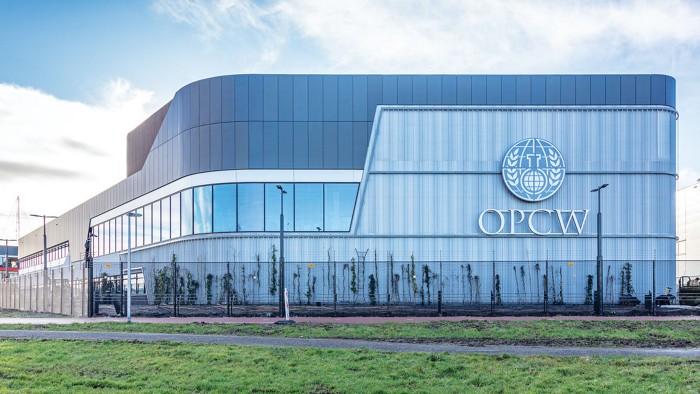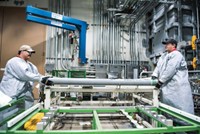Advertisement
Grab your lab coat. Let's get started
Welcome!
Welcome!
Create an account below to get 6 C&EN articles per month, receive newsletters and more - all free.
It seems this is your first time logging in online. Please enter the following information to continue.
As an ACS member you automatically get access to this site. All we need is few more details to create your reading experience.
Not you? Sign in with a different account.
Not you? Sign in with a different account.
ERROR 1
ERROR 1
ERROR 2
ERROR 2
ERROR 2
ERROR 2
ERROR 2
Password and Confirm password must match.
If you have an ACS member number, please enter it here so we can link this account to your membership. (optional)
ERROR 2
ACS values your privacy. By submitting your information, you are gaining access to C&EN and subscribing to our weekly newsletter. We use the information you provide to make your reading experience better, and we will never sell your data to third party members.
Chemical Weapons
The OPCW’s never-ending fight to eliminate chemical weapons
With most chemical weapons stockpiles gone, the Organisation for the Prohibition of Chemical Weapons looks to prevent new threats
by Dalmeet Singh Chawla, special to C&EN
June 4, 2023
| A version of this story appeared in
Volume 101, Issue 18

In 1997, the Chemical Weapons Convention—a first-of-its-kind global disarmament agreement—came into force. The treaty was championed by the Organisation for the Prohibition of Chemical Weapons (OPCW) with the aim of ridding the world of that class of weapons of mass destruction. In World War I alone, chemical weapons injured more than 1.3 million people, and over 100,000 of those died shortly after exposure, according to the OPCW.
Now the OPCW is approaching a new milestone: the destruction of all declared stockpiles of chemical weapons by its 193 member states. (Only four countries—Egypt, Israel, North Korea, and South Sudan—aren’t members.) In a few weeks, the destruction of the remaining stockpiles by the US will be completed, according to the OPCW.
In Pueblo, Colorado, the US is destroying between 600 and 700 4.2 in (107 mm) mortars containing sulfur mustard, also called mustard gas, a chemical warfare agent that was used in both World Wars and causes blistering of the skin.
Meanwhile, 2,000 km away in Kentucky, a facility is destroying 155 mm rockets containing sarin, a colorless, odorless, and tasteless nerve agent that can be released into the air as a spray and be fatal in small quantities.
“There’s a little remnant of chemical weapons left in the United States. It will be destroyed in the next few weeks, and this will be grounds for celebration,” Ambassador Fernando Arias, director general of the OPCW, told journalists at an event May 3. “Chemical weapons cannot exist in the 21st century in the world because they are abhorrent.”
And globally, more than 70,000 different poisons have been destroyed under supervision of OPCW inspectors. Jeffrey Kovac, a retired professor of chemistry at the University of Tennessee, Knoxville, who has written about the ethics of chemical weapons research, says the destruction of all declared stockpiled chemical weapons is a significant achievement. He notes that people have been calling for the abandonment of chemical weapons since World War I.
Now that its original mandate is largely complete, the OPCW can shift its focus to monitoring new and emerging threats and preventing the reemergence of destroyed chemical weapons. “The convention has a target: the destruction of all the chemical weapons from the world,” Arias said. “The goal is to prevent reemergence, with zero tolerance.”
As part of this strategy, on May 12, the OPCW inaugurated the Centre for Chemistry and Technology (ChemTech Centre) in Pijnacker-Nootdorp, the Netherlands, 12 km from its headquarters in The Hague. The 5,700 m2 building, which was under construction since June 2021, houses a technology and training hub that stores the sophisticated equipment used to identify and detect chemical weapons. It also has an atrium for lectures, movies, and receptions for dignitaries from member states.
The center, where a replica of one of the sulfur mustard mortars being destroyed in Colorado is on display, is intended to help the OPCW chemically analyze samples collected during inspections around the world and provide technical advice and education. It contains facilities for training OPCW staff, a series of laboratories, and an instruction space. With the new center, the OPCW hopes to host more training sessions for first responders to chemical explosions, accidents, and attacks around the world.
Fifty-six of the 193 OPCW member states, the European Union, and private donors provided more than $37 million to fund the new center. Officials at the OPCW, which was awarded the Nobel Peace Prize in 2013, hope it will become a repository of knowledge and expertise and a platform for collaboration between scientists and nonscientists.
The ChemTech Centre will conduct forensic research on all sorts of chemicals to identify possible security risks early. This work includes an increased focus on biotoxins, poisonous chemicals produced by living organisms. Two biotoxins—saxitoxin, which is derived from shellfish, and ricin, from the seeds of the castor plant—are mentioned in the Chemical Weapons Convention, but now the OPCW can use new facilities and new technologies to identify more naturally derived threats.

And biotoxins are just one aspect of biological warfare. Kovac says an OPCW counterpart for bioweapons needs to be developed to keep track of dangerous bacteria, viruses, and other microorganisms. “Bioweapons are likely much more dangerous than chemical weapons,” he says.
Even within the chemical space, fast-emerging technologies and the rise of artificial intelligence means the OPCW has its work cut out. For instance, more than 15,000 chemicals are registered in the American Chemical Society’s CAS Registry daily (ACS publishes C&EN). “With artificial intelligence, very dangerous chemicals can be designed and produced in a much easier way than before, which means that we have new challenges, and we have to be ready,” Arias said.
Another challenge for the OPCW is that the chemical industry often produces “dual-use” chemicals: those that are toxic but commonly used to make pesticides, pigments, pharmaceuticals, and more. And the global chemical industry has approximately doubled in size in the past 3 decades. A team of 80 OPCW inspectors carries out 241 verifications at sites every year to ensure chemicals do not fall into the hands of nonstate actors, or terrorists, and are not diverted for illegal purposes.
To help improve analytical techniques and track the reemergence of chemical weapons, the center will conduct research on chemical fingerprints—unique compositions of chemical impurities. These fingerprints can help trace chemical weapons to their possible origins.
Some of the center’s activities will aid the 30 designated laboratories in 20 nations that conduct off-site analyses of samples. For confidentiality, the OPCW doesn’t disclose the identities of labs contributing to the organization’s work, but officials confirm that all the labs in question have passed rigorous tests to demonstrate their ability to do such work.
Although reaching the end of 26 years of destroying chemical weapons is a significant milestone, this is not the end of chemical weapons. For instance, the OPCW acknowledges that questions remain about the thoroughness of reporting and claims about the destruction of declared stockpiles by Syria, a country that signed the convention and became an OPCW member in 2013. Akin to the United Nations, the OPCW doesn’t have the power to enforce laws or issue sanctions should any countries step out of line. Its findings, however, are presented to the UN Security Council, which can take such action.
The OPCW does also occasionally receive allegations of wrongdoing by nations blaming one another for housing undeclared chemical weapons. In such circumstances, OPCW inspectors conduct verifications. These inspectors regularly visit the site in question to verify that member states are fulfilling their obligations under the treaty—that is, that they have indeed destroyed their stockpiles and are not proliferating dangerous chemicals.
Although carefully maintained stockpiles are almost a thing of the past, remnants of war mean that chemical weapons are found around the world every day. On average, OPCW officials said at the May 3 event, somebody finds an old chemical weapon 4.3 times a day in countries spanning Asia, Central America, Europe, and North America.
One massive batch of chemical weapons that are still being destroyed are those abandoned by Japan on Chinese territory between 1920 and 1940. According to OPCW figures, in the past 26 years, 98,000 individual munitions have been recovered and are actively being destroyed.
But hundreds of thousands more chemical munitions are likely to exist; more than 300,000 old chemical weapons are thought to be in one unexcavated pit in North China alone. They include sulfur mustard, lewisite, chloroacetophenone, phosgene, trichloroarsine, and more.
Still, significant quantities of chemical weapons have been destroyed. When the convention came into force in 1997, member states declared having 72,000 metric tons (t) of such weapons—equivalent to the weight of 175 jumbo jets. That figure is now down to 127 t and is confined to one country, the US.
“The organization must keep pace with the progress in science and technology and the way it can impact the convention,” Arias said. “Our new ChemTech Centre will play an essential role in ensuring the OPCW can keep up with the exponential growth in scientific knowledge and technological instruments.”
“The center will be a hub for knowledge sharing and support the global efforts to ensure chemistry is used only for peaceful purposes,” Arias added. “Above all, the OPCW is an instrument in the service of peace and security in the world.”
Dalmeet Singh Chawla is a freelance science journalist based in London.




Join the conversation
Contact the reporter
Submit a Letter to the Editor for publication
Engage with us on Twitter